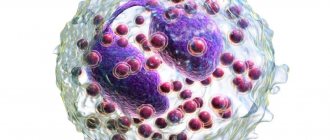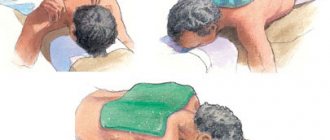Dementia is colloquially referred to as acquired dementia acquired during life rather than at birth.
It more often affects people of mature age and is associated with damage to the brain structure. The disease usually develops in one of two directions: atrophic or vascular. There are also mixed forms that combine both options.
Atrophic dementia is associated with the destruction of brain tissue and accounts for the largest percentage of cases. This includes the well-known Alzheimer's disease, as well as Pick's disease, Huntington's chorea, etc.
Vascular dementia develops against the background of “spoiled” cerebral circulation and accounts for approximately 15% of all dementors. It occurs with a variety of symptoms, which depends on the location of the pathological process, the area of the lesion and the caliber of the affected line.
Causes and essence of the disease
Vascular dementia develops due to disruption or cessation of blood circulation in one of the brain areas, as a result of which some brain cells die. The rate of progression of the process and the severity of symptoms will depend on how quickly the provoking factor acts.
Acute development of pathology is observed with stroke, ischemic or hemorrhagic. In the case of an ischemic stroke, a blood line is blocked by a thrombus. Its hemorrhagic form is characterized by rupture of the vessel. Both phenomena interfere with blood supply, which leads to irreversible death of cells in the brain area.
Typically, vascular dementia occurs in 25% of stroke patients. This happens if 50 ml of brain tissue is affected. The area and affected area play a big role. However, there are particularly sensitive areas of the brain, where even the slightest destruction entails disastrous consequences. These are, for example, the frontal lobes, visual hillocks.
For patients with vascular dementia, there is such a pattern: the first symptoms can appear either immediately after a stroke, or delayed, within six months. A period of 6 months is an indicative sign of vascular dementia. Typically, a stroke, especially a hemorrhagic one, leads to a rapid development of events, the appearance and increase of symptoms.
In a chronic destructive process, when small vessels are damaged, brain cell atrophy occurs gradually. Its compensatory mechanisms are activated, and symptoms increase gradually. The first signs are difficult to identify. Sometimes they hide not only from others, but also from the patient himself.
The main provoking factor that causes disruption of the patency and integrity of the blood network in the brain is atherosclerosis, that is, the deposition of sclerotic plaques on the vascular walls. Other reasons include:
- heart disease, cardiovascular failure;
- arterial hypertension;
- arterial hypotension;
- vasculitis – inflammation of the vessel wall;
- diabetes;
- hyperlipidemia;
- lack of estrogen;
- bad habits;
- excess body weight.
Organic brain damage
Symptoms of organic brain damage in children
The main sign of organic brain damage in children is psychoorganic syndrome. This condition is expressed in a violation of three aspects of brain function at once.
- Problems with memory - the child does not remember new information well and loses some of what has already been learned (partial amnesia). Moreover, with OPM, unreal (invented) memories may appear.
- Decreased intelligence - such children have difficulty concentrating, their thinking is impaired, and they have difficulty oriented in space.
- Affective disorders and reduced neurodynamics - children with organic brain lesions constantly experience weakness, dizziness and headaches, they are susceptible to depression and irritability. Children often display inappropriate emotions and “out-of-control” behavior.
- Delayed speech and intellectual development is another symptom of organic brain damage, which is characterized by impaired cognitive activity. This condition is not congenital, like mental retardation, but acquired. The functions of a child's damaged brain begin to disintegrate. Sometimes the developmental delay is so severe that the child cannot learn to care for himself.
There are also a number of focal symptoms , which depend on the area of the brain in which the disorders are localized.
Frontal lobe – facial and ocular muscles are paralyzed, the sense of smell is impaired and words are difficult to pronounce, difficulty performing purposeful movements, strange behavior on the verge of euphoria.
The parietal lobe is a violation of sensitivity, the inability to perform purposeful, meaningful actions, as well as the inability to learn reading and counting. Seizures with convulsions are common.
Temporal lobe - impaired sense of smell and hearing, problems with taste, there are hallucinations, emotionally unstable mood, partial or complete misunderstanding of speech.
Occipital lobe – visual impairment up to blindness, problems with coordination of movements and balance, hallucinations, convulsions during seizures.
Naturally, therapy and correction of APM should be prescribed based on the cause of its occurrence and development. For example, doctors recommend eliminating lesions caused by infection with the help of antibiotics, antiviral drugs and immunostimulants. If APM has developed as a result of a tumor, then, first of all, care must be taken to remove it. You can't argue with that.
Official medicine suggests treating ischemic diseases of the brain with nootropic drugs , as well as using decongestant and vascular therapy.
It is imperative to remember that drug therapy cannot but have side, sometimes harmful, consequences .
Eliminating the consequences is often more difficult and longer than the main violation.
But even in the case of successful drug therapy, you CANNOT do without psychological and correctional therapy.
If your child:
- very picky and capricious in choosing food
- reacts sharply to weather changes
- he gets carsick
- he's inattentive
- speaks poorly
- restless
- cries often
- clumsy
- lazy
Do you think that all these are character traits? In fact, these are neurological problems that may be associated with organic brain damage. If these violations are ignored now, then in the future they can cause serious behavioral disorders, speech delays and general development, and subsequently difficulties in learning at school.
The fact is that at an early age the consequences of many neurological disorders can be easily corrected and forgotten about them forever. But in adolescence, small problems often turn into big ones and are already very difficult to cope with.
Therefore, it is better not to postpone a visit to a neurologist and neuropsychologist.
It is especially important to conduct neuropsychological diagnostics in children before entering grade 1, to identify and correct neuropsychological disorders in a timely manner so that children do not develop “school failure”, which will affect not only the learning process, but also the psychological state of the child.
For example, in the temporal lobe of the left hemisphere there are areas “responsible” for the sound analysis of speech. If neuropsychological tests that check the state of this area of the brain are performed incorrectly, it is possible not only to diagnose its immaturity, but also to predict the occurrence of certain types of errors in speaking, writing, reading and remembering information.
General groups of symptoms
The disease distinguishes two groups of disorders: cognitive and neurological.
Cognitive disorders come to the fore, that is, regression of cognitive and thinking functions.
At the initial stage of the disease, memory is primarily affected. At first these are subtle changes. A person forgets some events, individual names and dates, and cannot find the right word to express a thought. The process of assimilation of new knowledge worsens, and it becomes increasingly difficult for the patient to remember and analyze new information.
Gradually, amnestic symptoms increase. The person does not grasp the meaning of what was said, and it becomes more and more difficult to find words. Because of this, his speech becomes meager, his sentences are short and monosyllabic. If talkativeness manifests itself, then it is incoherent; letters in words can be rearranged, words can be replaced. The person himself does not understand the meaning of what he said. Speech impairment leads to difficulties with writing and reading.
Amnesia occurs in the following forms:
- progressive - the patient begins to forget what happened to him recently, and then earlier events;
- fixation – inability to perceive, analyze, store new material, current events. Consciousness in such patients is preserved; they remember well the events of the past, but cannot remember what they talked about with the person 5 minutes ago. Having bought milk, brought it home and put it in the refrigerator, a few minutes later they are going to the store again to buy it, since they have already forgotten that they purchased it;
- Paramnesia is false memories when the patient supplements reality with unreal events. For example, he may pass off as reality events read in a book or seen in a film, and believe that this actually happened to him. Or he simply fantasizes, passing off as reality what did not happen. It is possible that events may shift in time, that is, what happened many years ago is perceived by a person as having happened yesterday.
In addition to memory, other cognitive functions are affected in vascular dementia. Attention is scattered, it is impossible to fix it for a long time. Perception is disrupted. Thinking becomes inflexible. It is difficult to switch from one activity to another.
Often, as the process progresses, patients develop a symptom such as Korsakoff's syndrome, named after the doctor who first described it. It combines several symptoms. First of all, this is fixation amnesia. As already mentioned, the patient does not remember current events, but retains memory of the past. In this regard, he loses orientation in time and space. So-called amnestic disorientation develops.
There are also various variations of paramnesia: doubts about the occurrence of a particular event, their displacement in time, a mixture of fictional and true events.
Against this background, a person gets lost in an unfamiliar environment. He doesn't understand where he is. While in the hospital, he cannot find his bed, but in a familiar environment, at home, he finds his way around perfectly.
Neurological disorders
In the initial stage of the disease, neurological dysfunctions manifest themselves as general symptoms. Weakness and fatigue, absent-mindedness, and irritability appear. I am bothered by systematic headaches and sleep is disturbed. There is an unstable emotional background. Depressive states are possible. The person is unrestrained, hot-tempered, and embittered. Emotional incontinence usually manifests itself in violent crying or laughter, weakness.
Among other neurological indicators, cerebellar syndrome occurs, characterized by uncoordinated movements. It seems that the arms and legs are moving chaotically. Because of this, the gait changes: it becomes shaky, slack. The person appears to be drunk. Instability of the step provokes falls.
The disease causes accentuation of personality traits. For example, if previously a person was scrupulous and meticulous, then pathology turns him into a picky grumbler.
Pseudobulbar syndrome is expressed by a triad of signs:
- dysarthria - pronunciation disorder;
- dysphonia – loss of voice sonority;
- dysphagia – problems with swallowing.
There are cases of paralysis and paresis, but quite rarely. Muscle tone and reflexes are increased.
Quite often, malfunctions in the functioning of the pelvic organs occur, and epileptic seizures occur.
In general, dementia of vascular origin is characterized by narrowness and fixation of mental processes, loss of flexibility of thinking, fading of cognitive abilities, and a narrow range of interests.
Types of diseases
In clinical practice, and then in theory, a huge number of pathologies leading to malfunctions of the central nervous system were identified. The most common of them can be highlighted in a list:
- Vascular aneurysm. It is a pathogenic expansion of the vascular wall, which loses elasticity and risks rupture, leading to internal hemorrhage. It is very difficult to save a person in such cases.
- Atherosclerosis. Appears when there is micro-trauma to the vascular wall, at the site of damage a cholesterol plaque forms, and then a blood clot. The lumen of the blood channel becomes clogged, blocking the path to oxygen and microelement nutrition of neurons, which is why they begin to die.
- Stroke. A vascular anomaly that often develops in old age. Leads to the death of areas of the brain (BM) in which blood circulation is disrupted. In the hemorrhagic form of the attack, the canals rupture, leading to internal hemorrhage, and it is very difficult to save the patient. Ischemic stroke is less dangerous but more common.
- Alcoholic encephalopathy. Systematic drinking of alcohol leads to gradual, non-renewable death of neurons, as a result of which a person loses cognitive abilities, intelligence, and psycho-emotional stability.
- Intracranial hypertension. It manifests itself as high intracranial pressure caused by the growth of a tumor, cyst or aneurysm inside the head.
- Malformation. Congenital defect in the structure of the vascular network.
- Alzheimer's disease. Excessive production of a pathogenic protein enzyme that accumulates in brain tissue and destroys nerve cells. Next, the functioning of internal systems and organs fails, after which death occurs.
- Various tumors. Neoplasms from aggressively growing cells of the body.
- Epilepsy. Impaired bioelectrical function of the brain, as a result of which periodic convulsions develop.
- Hydrocephalus. It is characterized by impaired exchange of cerebrospinal fluid, which begins to accumulate in the intracranial cavities. There is constant pressure on the brain, which causes its functioning to suffer.
The signs of all these diseases are largely similar, if you do not take into account specific manifestations, which almost do not appear in the early stages.
Cases of vascular dementia
Scientists have established for certain that the Russian writer, imperial maid of honor Smirnova Alexandra Osipovna, whom A.S. once admired. Pushkin, suffered from vascular dementia.
From her youth, she was distinguished by her gloomy mood or its swings, insomnia. At the age of 40, she suddenly lost weight and became haggard. I didn’t want to see doctors. She was treated on her own: sermons, rituals. Her heredity was burdened with mental disorders.
At the age of 69, her condition worsened further. Her speech became incoherent, she rearranged syllables in words and distorted them. Memory suffered and behavior was disrupted. The mental state deteriorated sharply, reaching the level of mental disorder.
According to data collected from eyewitnesses, Alexandra Osipovna was diagnosed with “atherosclerotic dementia.”
Another famous writer, the author of Uncle Tom's Cabin, Harriet Beecher Stowe, was also diagnosed with vascular dementia. She devoted her entire life to caring for her large family, fighting poverty and disease. In the last years of her life, after the death of her husband, Harriet lived completely alone. She exhibited strange behavior. Sometimes she came to Twain’s house and wandered around the rooms there. She didn’t pay attention to anyone, she was aloof. After walking around a bit among the people, she returned home. Her mental abilities had completely deteriorated, she practically could not take care of herself. The patient's memory underwent special destructive changes.
Symptoms of cerebrospinal gravis
Depending on the predominant clinical manifestations, the following types of cerebrasthenic syndrome are distinguished:
1. Asthenohyperdynamic:
- fussiness;
- irritation for any reason;
- aggression (can even reach the use of physical force);
- restlessness;
- physical activity.
2. Asthenoadynamic or atenopathic:
- constant drowsiness, even after a normal night's sleep;
- lethargy;
- indifference;
- indifference to everything that happens around;
- laziness;
- inactivity;
- inactivity.
3. Asthenodysthymic or mixed variant, which combines the characteristics of other types. This is characterized by frequent mood swings, a rapid transition from apathy to aggression, and tearfulness. General symptoms:
- headache;
- dizziness;
- nausea, vomiting;
- disorders of the stomach and intestines (constipation, causeless diarrhea);
- vegetative manifestations: tremor of the eyelids, sweating of the skin;
- poor tolerance to heat and changes in atmospheric pressure.
Cerebroasthenia has its own periods of exacerbations and remissions, during which symptoms can either disappear altogether or be present at a minimal level. In some patients, remissions as such are not observed, and they constantly feel symptoms of exhaustion of the nervous system. Exacerbations are clearly associated with the presence of provoking factors - changes in the usual daily routine, lack of sleep, stress, increased mental and physical stress, bad habits.
Forms of vascular dementia
The brain provides us with conscious existence, being responsible for mental, emotional, and adaptive processes. Its substance is strictly structured. Each of its departments is responsible for its functions.
However, any part of the brain can undergo destructive changes, as a result of which a certain type of activity is disrupted. Based on this, several forms of the disease are distinguished, differing not only in location, but also in the caliber of the affected vessels.
Dysmnestic or lacunar dementia occurs against the background of destruction of small-diameter vessels. As a result, multiple infarct foci appear in the thickness of the white and gray matter. This is the most classic variant of the course of the disease, in which all pathological manifestations are not clearly expressed. There is a measured decrease in intellectual abilities, mild memory impairment, and slight slowness of psychomotor skills.
The multi-infarction form is accompanied by damage to vessels of medium diameter, and usually develops in non-acute pathological processes. Its manifestations are insignificant and go unnoticed for a long time even by the patient himself. Its course is gradual. The disorders first progress and then freeze at a certain stage until the next micro-stroke. Among the symptoms of this type of disease, cognitive impairment comes to the fore. Neurological and emotional disorders gradually develop.
Subcortical vascular dementia is a disease of small vessels, against which atrophy of white matter cells occurs with the formation of ischemic areas. Scientists see the reason for this process in the accumulation of amyloid in the walls of the arteries, followed by its inflammation. The clinical picture of the disease is somewhat atypical. It can occur as Alzheimer's disease or as isolated dementia.
Autoimmune vasculitis, such as systemic lupus erythematosus and panarteritis, cause another form of the disease - cerebral vasculitis. It is expressed by dementia and confusion. As a rule, it affects patients over 50.
Mixed dementia combines two forms: vascular and atrophic, that is, Alzheimer's type. Therefore, in the picture of the disease one can observe symptoms of both vascular dementia and Alzheimer's disease, but the latter prevail over the former.
Binswanger's disease
The pathology is named after its discoverer and is subcortical atherosclerotic encephalopathy. Develops as a result of damage to small cerebral vessels and is a fairly common form of dementia: about 1/3 of all dementors.
It has been established that arterial hypertension plays a major role in the development of pathology. It was observed in 80% of patients with this form. Most often, the disease starts after 50 years and begins suddenly. The first signs of it may be a transient disturbance of cerebral circulation, accompanied by sudden paralysis, which, however, also suddenly disappears. Other signs include small strokes and parkinsonism. A magnetic gait is observed when the legs seem to stick to the floor.
Emotional incontinence appears in the form of sudden laughter or crying, speech is impaired, and control over vital functions (for example, urination) is lost. Problems with memory and thinking appear already at the beginning of the disease.
The symptoms of the pathology are quite varied. After all, the process causes extensive damage to brain tissue with ischemia, destruction of nerve cell processes, and demyelination of nerve fibers. The process is accompanied by steady progression, although cases of persistent remission are possible.
Brain stem tumors
The experience of a number of surgeons has shown that benign circumscribed tumors of the trunk can be successfully removed. In these cases, surgery can significantly prolong the patient's life and improve his condition.
Such tumors are detected only in 20-25% of patients. In other cases, for diffusely growing trunk gliomas, radiation therapy may be recommended, the effectiveness of which has not yet been precisely studied.
Surgical treatment options for brainstem tumors are very limited. Although only surgical removal of neoblastoma leads to stabilization of the disease with a low probability of its progression within 5-7 years. However, for many affected children, the main treatment method is radiation therapy. Symptomatic improvement after its implementation is observed in 75% of cases, but most patients die early after completion.
Radiation therapy technique
Pontine gliomas exhibit infiltrating growth, often involving the midbrain (quadrigeminal) and cerebellum in the tumor process. This must be remembered when choosing the volume of tissue to be irradiated. Therefore, it includes the brain stem from the quadrigeminal to the level of the first cervical vertebra (C1). It is rational to use opposing fields and high-energy radiation.
Local radiation may be recommended for midbrain tumors. In this case, the target includes the primary tumor with 1-2 cm of adjacent tissue.
Subarachnoid metastasis occurs in 15-20% of children with brainstem gliomas. The most characteristic feature of these tumors is local progression of the disease.
Dose. A number of researchers have shown that only 20-30% of children with brain stem gliomas have a relatively good prognosis after irradiation with a total dose of 50-55 Gy. The low percentage of achieving local tumor destruction forced the search for new ways of temporary dose administration, which led to the use of hyperfractionation. Yes, Edwardsetal. (1989), irradiating the tumor with 1 Gy twice a day to a total dose of 72 Gy, noted that 30% of children lived for 2 years, and among patients with a diffuse tumor, the average survival time was 1 year.
High-dose irradiation, which became possible with the use of hyperfractionation, turned out to be more effective for locally limited tumors of the brain stem, especially for diffuse infiltrating blastomas, compared with irradiation carried out in the usual course.
Diagnostics
First of all, the diagnosis of the disease is carried out on the basis of the clinical picture, or, more precisely, the presence of cognitive and neurological defects in it. They significantly poison the patient’s life and do not disappear even with clear consciousness.
Correctly identifying symptoms, and subsequently prescribing effective treatment, allows timely diagnosis. Thanks to visual research methods, it has become very simplified, and this makes it possible to recognize the pathology in a timely manner without delaying treatment.
Among these methods are prescribed:
- MRI, CT;
- angiography, which allows you to assess the condition of blood vessels;
- rheoencephalography, which determines blood filling of blood vessels;
- EEG, which records the bioelectric signals of brain cells;
- nuclear resonance imaging, visualizing white matter, etc.
Consultations with related specialists are required: neurologist, cardiologist, psychiatrist. Blood pressure is systematically monitored.









